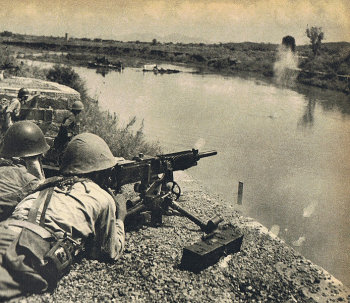![]() The Pacific War Online Encyclopedia
The Pacific War Online Encyclopedia
|
| Previous: Changpeh | Table of Contents | Next: Chao Shih-ling |

Changsha (Chángshā; 112.988E 28.192N) was founded over 2000 years ago and became an educational and cultural center. It was opened to foreign trade in 1904. Vessels of up to 500 tons were able to reach the river port from the Yangtze via Tunting Lake, and it was a major rice marketing center. The population was in the ballpart of 400,000 persons in 1941.
The city was bombed starting on 8
November 1938, and on the 12th Chiang
Kai-shek ordered the city put to the torch as part of a
scorched-earth policy. However, the anticipated Japanese move against the city
did not materialize. The Japanese first marched on Changsha on 29
September 1939, but this was a limited campaign aimed more at
keeping the Chinese
off-balance than at seizing territory. However, Chiang hoped to
trap a significant Japanese force in the city, positioning troops
of 9
War Area under Ch'en
Ch'eng on the flanks of the Japanese advance. The Japanese
fought their way out of the trap but suffered significant casualties, and the Chinese
claimed a great victory.
The second campaign, beginning on 18 September 1941, was the brain child of Anami Korechika, commander of 11 Army, who in April 1941 proposed a campaign to simultaneously destroy the Kuomintang armies (300,000 strong) defending the area and deprive the Chinese of its grain production. Anami believed that this would be sufficient to end the war in China. The proposal was shelved after Germany invaded Russia in June, but was revived in August 1941 after the Japanese command decided to move against southeast Asia instead of Russia. Anami attacked with four divisions and reached the city in ten days, but a Chinese counteroffensive against I'chang forced the Japanese to withdraw after suffering numerous casualties. It was probably the worst defeat the Japanese suffered in China prior to the outbreak of war in the Pacific, and demonstrated to the Japanese that the Chinese were not about to capitulate. However, it was a costly victory; the Japanese later reported casualties of 850 killed and 2700 wounded while claiming Chinese casualties of 44,000 killed and 4000 prisoners. Japanese frustration over the protracted Chinese war combined with the threat of American economic sanctions was an important factor in bringing about the Pacific War.
The third Changsha campaign was launched on 24 December 1941 and was aimed largely at keeping the Chinese preoccupied while the Japanese seized Hong Kong. 11 Army mustered 120,000 men and 600 artillery pieces and was supported by the aircraft of 1 Air Brigade, the largest air formation left in China after most were pulled out to participate in the Centrifugal Offensive. When Hong Kong fell on 23 December 1941, the Japanese decided to continue the Changsha campaign, which had gone well so far, and capture the city for its value as a symbol of Chinese defiance. This played into the hands of the Chinese, whose commander, Hsueh Yueh, allowed the Japanese to penetrate deeply into the Changsha area, then cut off the two Japanese spearhead divisions. The Japanese were forced to retreat by 15 January 1942 after losing tens of thousands of casualties.
The Japanese captured the city again on 18 June 1944
with relative ease as part of the Ichi-go offensive.
Unlike the previous attacks on the city, this attack was well
supported on the flanks, negating the previously succesful Chinese
strategy of allowing the
Japanese to advance to the city, then attacking their flanks. The
Chinese artillery on
Yueh-lu Shan, a 900' (300 m) peak
northwest of the city, was driven off by 34
Division on 16 June while 58
Division, which had crossed the Liu-yang Ho River on
10 June against negligible opposition, turned west to
attack the city. The defending 4 Army
abandoned the town over the next two days, claiming they had been
driven out by gas
attack, but American observers saw little evidence of this.
Changsha
was occupied by the Japanese on 18 June, while the commander of 4
Army,
Chang Teh-nang, was
executed for cowardice.
A counterattack
in July failed to dislodge the Japanese.
References
Generals.dk
(accessed 2012-5-18)
Populstat.info
(accessed 2014-6-8)
Romanus and Sunderland (1953; accessed 2012-5-18)
The Pacific War Online
Encyclopedia © 2007, 2009, 2012, 2014-2015 by Kent G. Budge. Index